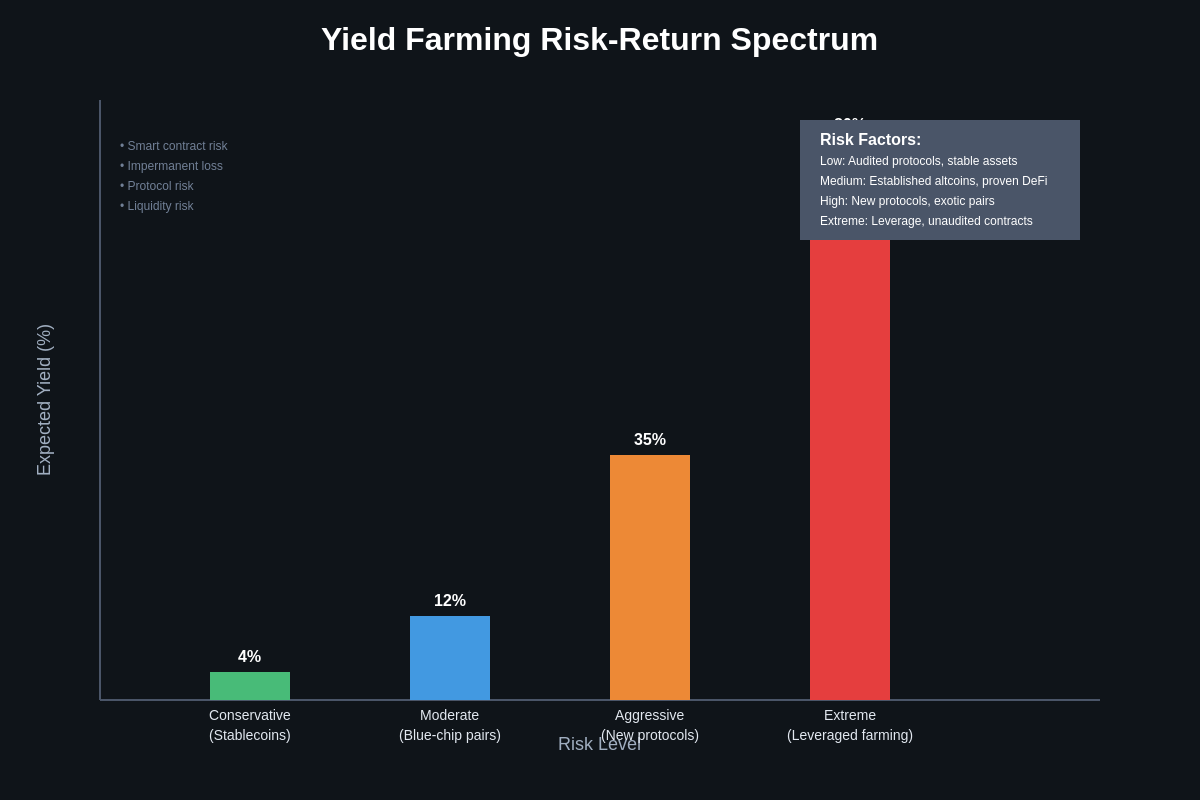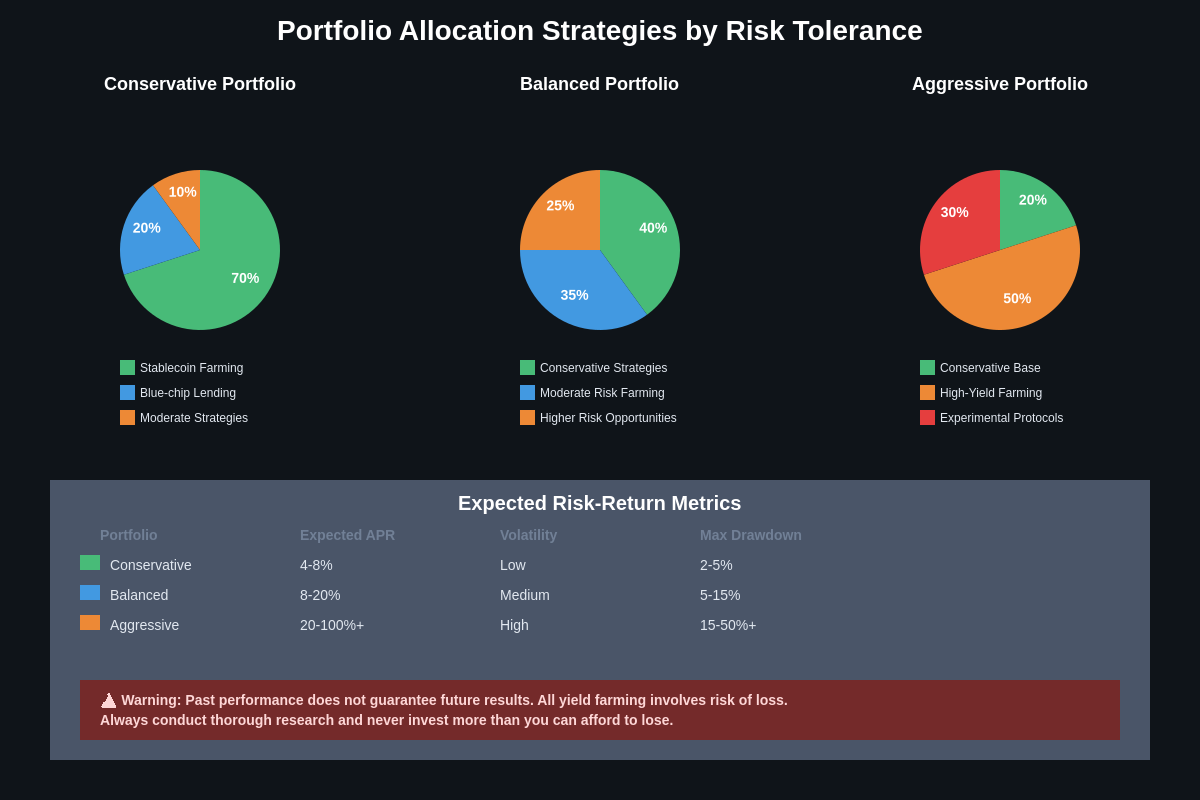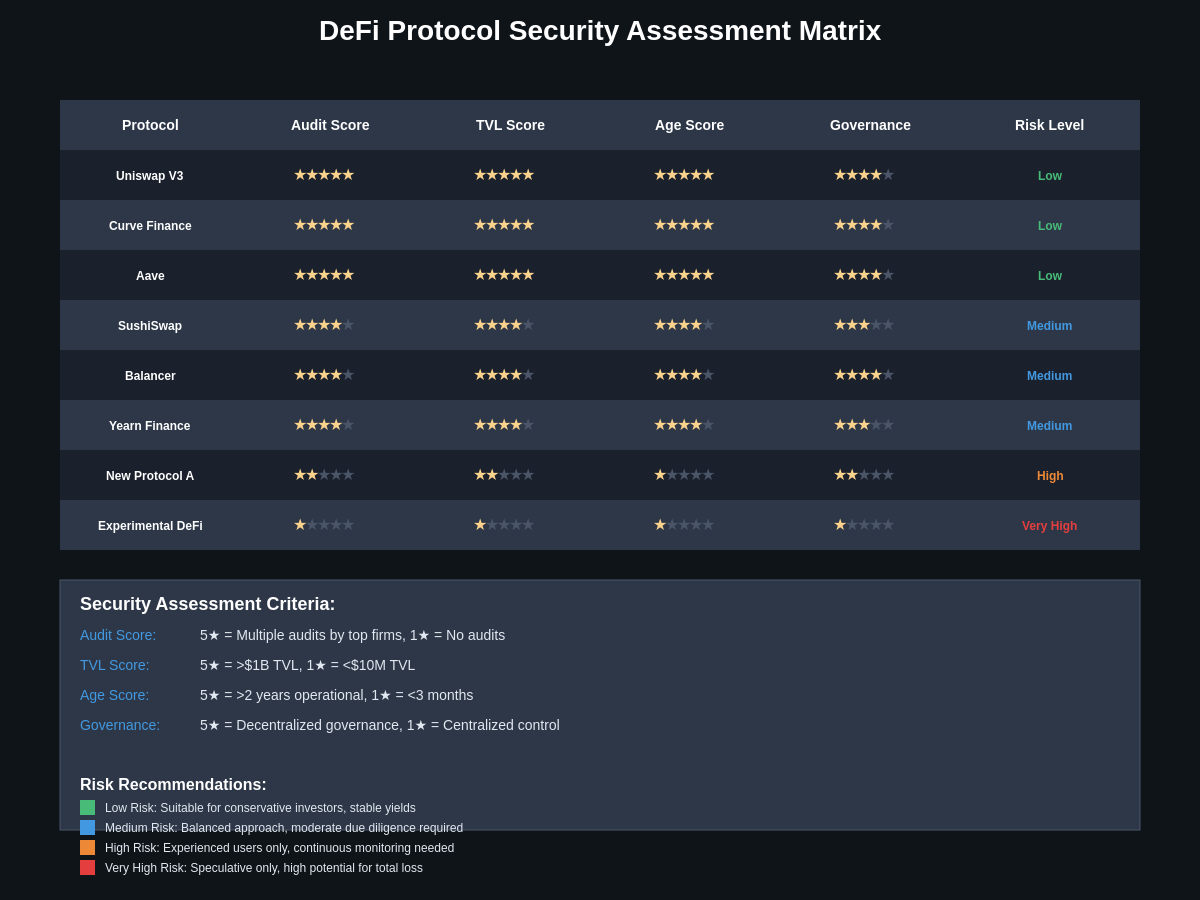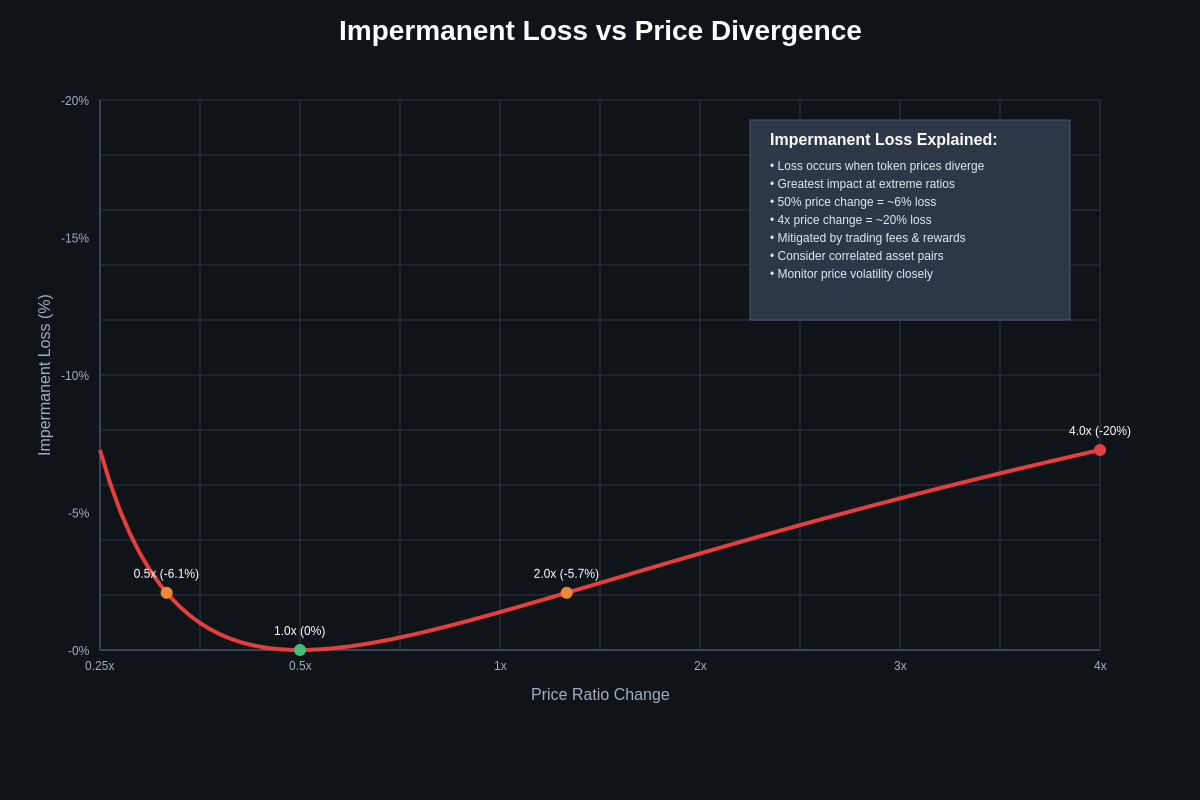Understanding Risk-Adjusted Yield Farming
Yield farming has emerged as one of the most compelling opportunities in decentralized finance, offering investors the potential to earn substantial returns on their cryptocurrency holdings through various liquidity provision mechanisms. However, the landscape of yield farming opportunities presents a complex spectrum of risk-reward profiles that require careful analysis and strategic positioning to navigate successfully. Understanding how to align yield farming strategies with individual risk tolerance levels has become essential for both institutional and retail participants seeking to optimize their DeFi participation while managing potential downside exposure.
The fundamental principle of yield farming involves providing liquidity to decentralized protocols in exchange for rewards, typically distributed in the form of protocol tokens, trading fees, or additional yield-bearing assets. However, the apparent simplicity of this mechanism masks a sophisticated ecosystem where different protocols, token pairs, and farming strategies present vastly different risk characteristics that can significantly impact long-term portfolio performance and capital preservation objectives.
Risk tolerance in yield farming encompasses multiple dimensions including smart contract risk, impermanent loss exposure, token volatility, protocol governance risks, and liquidity considerations that can affect the ability to exit positions during market stress. Conservative investors typically prioritize capital preservation and predictable returns over maximum yield generation, while aggressive investors may accept higher volatility and protocol risks in pursuit of potentially outsized returns from newer or more experimental farming opportunities.

Conservative Yield Farming Strategies
Conservative yield farming strategies focus primarily on capital preservation and consistent returns through established protocols with proven track records and minimal exposure to exotic tokens or experimental mechanisms. These approaches typically involve providing liquidity to stablecoin pairs or major cryptocurrency pairs on well-audited platforms that have demonstrated resilience through multiple market cycles and stress events.
Stablecoin farming represents the most conservative approach to yield farming, involving the provision of liquidity to pairs such as USDC-USDT, DAI-USDC, or other established stablecoin combinations that minimize impermanent loss risk while generating returns through trading fees and protocol rewards. Platforms like Curve Finance have become particularly popular for stablecoin farming due to their specialized automated market maker algorithms that reduce slippage and optimize returns for similar-valued assets. The Curve Finance platform has consistently demonstrated its ability to provide stable returns with minimal principal risk.
Blue-chip cryptocurrency pairs such as ETH-USDC or BTC-USDC on established platforms like Uniswap V3 or SushiSwap offer slightly higher risk but potentially greater returns than pure stablecoin strategies. These approaches benefit from the liquidity depth and institutional adoption of major cryptocurrencies while providing exposure to potential upside from cryptocurrency appreciation. The key to success with these strategies lies in careful position sizing and active management of liquidity ranges to minimize impermanent loss while maximizing fee generation.
Conservative farmers should also consider lending protocols such as Aave, Compound, or MakerDAO, which offer predictable returns through interest rate mechanisms without the complexities of liquidity provision or impermanent loss concerns. These platforms have established themselves as core DeFi infrastructure with extensive security audits and proven resilience, making them suitable for risk-averse participants seeking steady yield generation.
Moderate Risk Yield Farming Approaches
Moderate risk yield farming strategies seek to balance return optimization with reasonable risk management through diversified approaches that may include exposure to established altcoins, multi-protocol strategies, and selective participation in proven but higher-yielding opportunities. These strategies typically involve more active management and sophisticated risk assessment compared to conservative approaches while avoiding the highest-risk experimental protocols.
Diversified liquidity provision across multiple established protocols represents a core moderate-risk strategy, spreading exposure across platforms like Uniswap, SushiSwap, Balancer, and Curve to reduce concentration risk while capturing different yield opportunities. This approach requires careful monitoring of protocol developments, yield fluctuations, and market conditions that may affect optimal allocation across different platforms and token pairs.
Altcoin farming strategies targeting established projects with strong fundamentals and reasonable volatility characteristics offer moderate-risk participants opportunities for enhanced returns through selective exposure to promising cryptocurrency projects. Pairs involving tokens like LINK-ETH, UNI-ETH, or AAVE-ETH provide exposure to established DeFi protocols while maintaining some degree of correlation with broader cryptocurrency markets. Successful implementation of these strategies requires fundamental analysis of underlying protocols and careful timing of entry and exit points based on market conditions and token performance analysis.
Multi-protocol yield optimization strategies involve actively moving capital between different farming opportunities based on changing yield rates, protocol incentives, and market conditions. These approaches can significantly enhance returns through tactical allocation decisions but require substantial time investment and sophisticated understanding of DeFi protocol mechanics. Platforms like Yearn Finance have automated many aspects of this strategy through vault mechanisms that optimize yields across multiple protocols.

Aggressive High-Risk Farming Strategies
Aggressive yield farming strategies target maximum return potential through exposure to newer protocols, experimental mechanisms, and higher-volatility token pairs that offer substantial reward opportunities alongside commensurate risks. These approaches are suitable for experienced DeFi participants with high risk tolerance and the ability to absorb potential total loss of invested capital in pursuit of potentially extraordinary returns.
New protocol farming represents one of the highest-risk categories, involving early participation in recently launched platforms that may offer extremely high initial yields to attract liquidity and establish market presence. While these opportunities can generate exceptional returns for early participants, they carry substantial risks including unaudited smart contracts, potential protocol exploits, governance attacks, and the possibility of complete protocol failure or token devaluation.
Leveraged yield farming strategies amplify both potential returns and risks through the use of borrowed capital to increase position sizes in farming opportunities. Platforms like Alpha Finance, Gearbox, or Impermax enable users to borrow assets against collateral to increase their farming exposure, potentially multiplying returns but also magnifying losses and introducing liquidation risks during adverse market conditions. These strategies require sophisticated risk management including careful monitoring of collateral ratios, liquidation thresholds, and market volatility.
Exotic token pair farming involves providing liquidity to pairs containing newer or more volatile cryptocurrencies that may offer higher yields due to reduced competition and higher trading activity. While these opportunities can be lucrative, they expose farmers to significant impermanent loss risks, token-specific risks, and liquidity challenges that may complicate exit strategies during market stress.
Risk Assessment and Due Diligence Framework
Effective yield farming across all risk tolerance levels requires a comprehensive framework for evaluating opportunities and managing ongoing exposure to various risk factors that can significantly impact returns and capital preservation. This framework should encompass technical analysis of smart contracts, fundamental analysis of underlying protocols, market analysis of token pairs, and ongoing monitoring of risk factors that may change over time.
Smart contract security analysis represents the foundation of yield farming due diligence, involving review of protocol audits, historical security incidents, and ongoing security practices implemented by development teams. Investors should prioritize protocols that have undergone multiple audits by reputable security firms, have established bug bounty programs, and demonstrate ongoing commitment to security best practices. The complexity and experimental nature of many DeFi protocols means that even audited contracts may contain vulnerabilities that could result in total loss of deposited funds.
Protocol tokenomics and governance analysis helps assess the long-term sustainability and potential risks associated with farming rewards distributed in protocol tokens. Factors to consider include token emission schedules, governance mechanisms, treasury management, revenue generation models, and the alignment of incentives between protocol developers and liquidity providers. Understanding these dynamics is crucial for predicting the sustainability of high yields and the potential for token value appreciation or depreciation over time.
Market analysis and impermanent loss modeling enable farmers to understand potential scenarios for their liquidity provision strategies and make informed decisions about position sizing and duration. Tools and calculators for impermanent loss analysis can help quantify potential losses under different market scenarios, while correlation analysis between token pairs can inform diversification strategies and risk management approaches.
Platform Selection and Protocol Analysis
The selection of appropriate platforms and protocols forms the cornerstone of successful yield farming strategies, requiring evaluation of multiple factors including security track records, liquidity depth, fee structures, reward mechanisms, and long-term sustainability prospects. Different platforms excel in different areas and may be more suitable for specific risk tolerance levels and farming objectives.
Established platforms like Uniswap, Curve, and Aave have demonstrated their resilience through multiple market cycles and have established themselves as core DeFi infrastructure with deep liquidity and institutional adoption. These platforms typically offer more predictable returns with lower protocol risk, making them suitable for conservative and moderate-risk strategies. Their extensive audit history, large developer communities, and proven governance mechanisms provide additional confidence for long-term farming strategies.
Newer platforms and emerging protocols may offer higher yields and innovative features but require more careful evaluation of risks and potential rewards. Factors to consider include the experience and track record of development teams, the comprehensiveness of security audits, the novelty and complexity of implemented mechanisms, and the level of community adoption and liquidity provision. While these platforms may offer exceptional opportunities, they also carry higher risks of exploit, failure, or sudden changes in tokenomics that could affect farming returns.
Cross-chain farming opportunities have expanded significantly with the growth of alternative blockchain networks and bridging technologies, offering access to different risk-reward profiles and potentially higher yields due to lower competition. However, cross-chain farming introduces additional risks including bridge security, network stability, and the complexity of managing assets across multiple blockchains. Platforms operating on networks like Polygon, Arbitrum, Avalanche, or Binance Smart Chain may offer attractive yields but require careful consideration of network-specific risks and bridging mechanisms.

Impermanent Loss Management Strategies
Impermanent loss represents one of the most significant risks in yield farming, particularly for strategies involving volatile token pairs, and requires sophisticated understanding and management techniques to minimize its impact on overall returns. The mathematical relationship between token price movements and liquidity provider returns means that impermanent loss can substantially erode farming profits even when substantial fee income and reward tokens are generated.
Understanding impermanent loss mechanics is essential for all yield farming participants, as this phenomenon affects virtually all automated market maker liquidity provision strategies except those involving highly correlated assets like stablecoin pairs. Impermanent loss occurs when the relative prices of tokens in a liquidity pool change compared to the time of deposit, with greater price divergence resulting in larger impermanent losses that may exceed the fees and rewards generated through farming activities.
Strategic approaches to minimizing impermanent loss include focusing on correlated asset pairs, using concentrated liquidity strategies in platforms like Uniswap V3 to optimize fee generation relative to price exposure, and employing hedging strategies that can offset impermanent loss through derivative positions or additional farming strategies. Some farmers employ delta-neutral strategies that combine liquidity provision with perpetual futures positions to maintain price-neutral exposure while capturing farming rewards.
Active management of liquidity positions can help minimize impermanent loss through strategic timing of deposits and withdrawals based on market conditions and technical analysis. This approach requires significant time investment and market expertise but can substantially improve risk-adjusted returns for dedicated yield farmers willing to actively monitor and adjust their positions based on market developments and price action analysis.

Portfolio Allocation and Diversification
Effective portfolio allocation across different yield farming strategies requires balancing return optimization with risk management through diversification across protocols, token pairs, risk levels, and time horizons. The correlation between different farming strategies and their exposure to various risk factors should inform allocation decisions and ongoing portfolio management approaches.
Conservative investors might allocate the majority of their yield farming portfolio to stablecoin and blue-chip strategies while maintaining smaller allocations to moderate-risk opportunities for return enhancement. A typical conservative allocation might involve 70-80% in stablecoin farming and established protocol lending, 15-20% in major cryptocurrency pair farming, and 5-10% in carefully selected moderate-risk opportunities for diversification and return enhancement.
Moderate-risk investors can afford higher allocations to diversified strategies and selective exposure to higher-yielding opportunities while maintaining meaningful allocations to conservative strategies for stability. A balanced moderate-risk portfolio might allocate 40-50% to conservative strategies, 30-40% to diversified moderate-risk approaches, and 10-20% to carefully selected higher-risk opportunities with exceptional return potential.
Aggressive investors may concentrate larger portions of their portfolios in high-risk, high-reward strategies while maintaining some conservative positions for risk management and liquidity purposes. However, even aggressive strategies should incorporate diversification principles to avoid concentration in single protocols or token pairs that could result in substantial losses from individual failures or exploits.
Monitoring and Risk Management Tools
Continuous monitoring and sophisticated risk management tools are essential for successful yield farming across all risk tolerance levels, enabling farmers to track performance, identify emerging risks, and make timely adjustments to their strategies based on changing market conditions and protocol developments. The dynamic nature of DeFi markets and the complexity of farming strategies require systematic approaches to monitoring and risk management.
Portfolio tracking tools and dashboards enable farmers to monitor their positions across multiple protocols and blockchains, providing consolidated views of performance, yields, and risk metrics. Platforms like DeBank, Zapper, or Zerion offer comprehensive portfolio tracking capabilities that can help farmers understand their overall exposure and performance across different farming strategies and protocols.
Risk monitoring systems should track various metrics including impermanent loss exposure, protocol-specific risks, market volatility, liquidity conditions, and correlation between different positions. Automated alerts can help farmers respond quickly to changing conditions that may require position adjustments or risk management actions. Many farmers develop custom monitoring solutions using blockchain data and API integrations to track their specific risk metrics and performance indicators.
Performance analysis and strategy optimization require ongoing evaluation of risk-adjusted returns, comparison with alternative opportunities, and assessment of changing market conditions that may affect optimal allocation decisions. This analysis should consider transaction costs, gas fees, opportunity costs, and the time value of money when evaluating the effectiveness of different farming strategies and making decisions about strategy modifications or reallocation.
TradingView Technical Analysis
Tax Implications and Compliance Considerations
Yield farming activities generate complex tax implications that vary significantly across jurisdictions and require careful consideration and planning to ensure compliance with applicable regulations while optimizing after-tax returns. The treatment of farming rewards, impermanent loss, and strategy changes can substantially impact the net profitability of yield farming strategies and should be integrated into strategy selection and execution decisions.
Tax treatment of yield farming rewards varies considerably between jurisdictions, with some treating farming rewards as ordinary income at the time of receipt while others may allow for different treatment based on the nature of the rewards and the activities generating them. Understanding the specific tax implications in relevant jurisdictions is crucial for accurate strategy evaluation and compliance planning.
Record keeping requirements for yield farming activities can be substantial, particularly for active strategies involving multiple protocols and frequent position adjustments. Farmers should maintain detailed records of all transactions, reward receipts, impermanent loss calculations, and strategy changes to support accurate tax reporting and compliance activities. Various tools and services are available to help automate record keeping and tax reporting for DeFi activities.
Regulatory compliance considerations are evolving rapidly as governments worldwide develop frameworks for DeFi activities and cryptocurrency taxation. Farmers should stay informed about regulatory developments in their jurisdictions and consider consulting with qualified tax and legal professionals to ensure compliance with applicable requirements and optimize their tax strategies.
Future Trends and Evolution of Yield Farming
The yield farming landscape continues to evolve rapidly with technological innovations, regulatory developments, and market maturation driving new opportunities and challenges for participants across all risk tolerance levels. Understanding emerging trends and potential future developments can help farmers position themselves advantageously and adapt their strategies to changing market conditions.
Technological innovations including Layer 2 scaling solutions, cross-chain interoperability protocols, and advanced automated market maker designs are creating new categories of yield farming opportunities with different risk-reward characteristics. These developments may reduce transaction costs, improve capital efficiency, and enable more sophisticated farming strategies that were previously economically unfeasible or technically impossible.
Regulatory clarity and institutional adoption are likely to drive increased participation in more established farming strategies while potentially limiting access to certain high-risk opportunities. This evolution may lead to compression of yields in established strategies while creating new opportunities in compliant and institutionally accessible farming products and services.
The maturation of DeFi protocols and the development of professional-grade risk management and strategy optimization tools may democratize access to sophisticated farming strategies while improving risk-adjusted returns across all participant categories. Integration with traditional financial services and the development of regulated DeFi products may expand the addressable market for yield farming while introducing new considerations for strategy selection and execution.
TradingView Advanced Trading Tools
Disclaimer: This article is for informational purposes only and does not constitute financial advice. Yield farming involves significant risks including potential loss of capital, smart contract vulnerabilities, impermanent loss, and regulatory uncertainties. Past performance does not guarantee future results. Readers should conduct their own research and consult with qualified financial advisors before making investment decisions. The author and publisher disclaim any liability for losses or damages resulting from the use of information contained in this article. Cryptocurrency investments are highly volatile and may not be suitable for all investors.